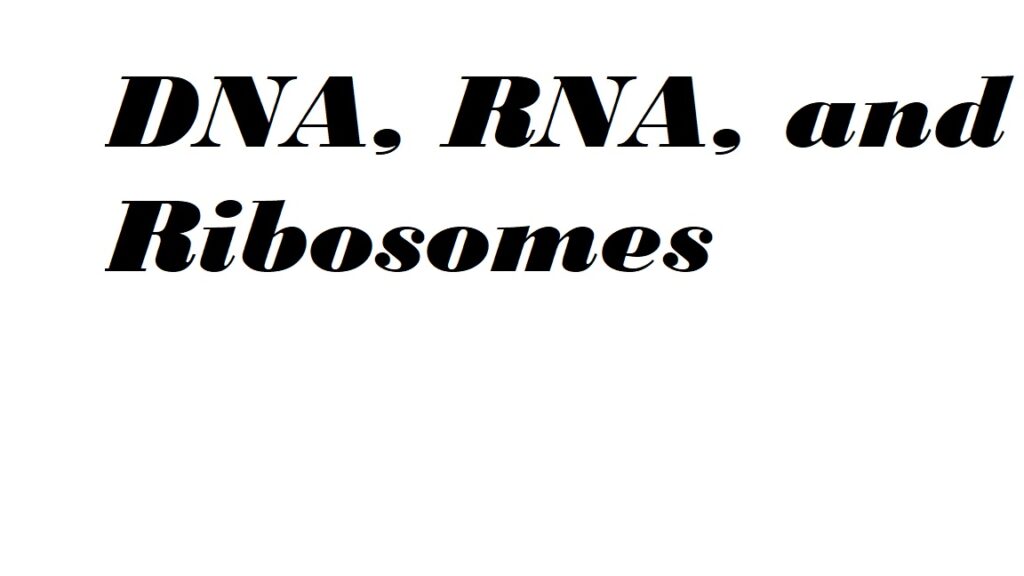DNA, RNA, and Ribosomes in ACT Science Section are not important to memorize, but it is essential to have some basic back ground.
DNA, RNA, and Ribosomes Explanation In ACT Science Section:
DNA (Deoxyribonucleic Acid):
DNA is a molecule that carries the genetic instructions used in the growth, development, functioning, and reproduction of all known living organisms.
It is a double-stranded helical molecule made up of nucleotides that contain a sugar (deoxyribose), a phosphate group, and one of four nitrogenous bases: adenine (A), thymine (T), cytosine (C), and guanine (G).
DNA is located in the cell nucleus and can replicate itself to pass genetic information from one generation of cells to the next.
RNA (Ribonucleic Acid):
RNA is a molecule similar to DNA but with some key differences, such as being single-stranded and containing the sugar ribose instead of deoxyribose.
It plays various roles in protein synthesis, including carrying genetic information from DNA to the ribosomes and acting as a template for protein synthesis (mRNA), bringing amino acids to the ribosome for protein assembly (tRNA), and catalyzing the formation of peptide bonds during translation (rRNA).
Ribosomes:
Ribosomes are cellular organelles responsible for protein synthesis in all living cells.
They consist of two subunits made of proteins and ribosomal RNA (rRNA).
Ribosomes read the mRNA produced from DNA and use the information to assemble amino acids into proteins through a process called translation.
DNA, RNA, and ribosomes in ACT Section summary
DNA stores genetic information, RNA transcribes and translates this information to produce proteins, and ribosomes act as the machinery for protein synthesis within the cell. This coordinated process is essential for the growth, development, and functioning of all living organisms.
Questions
Question 1:
Which of the following correctly describes the main function of ribosomes in a cell?
A) Storing genetic information
B) Synthesizing lipids
C) Converting sunlight into energy
D) Protein synthesis
Answer D) Protein synthesis is the correct answer. Ribosomes are the cellular machinery responsible for building proteins.
Question 2:
What is the primary function of RNA in the process of protein synthesis?
A) Providing the template for DNA replication
B) Acting as a structural component of the cell membrane
C) Carrying amino acids to the ribosome for protein assembly
D) Storing genetic information for future use
Answer C) Carrying amino acids to the ribosome for protein assembly is the correct answer. This is the role of transfer RNA (tRNA).
Question 3:
In a DNA molecule, which nitrogenous base pairs with adenine?
A) Thymine
B) Cytosine
C) Guanine
D) Uracil
Answer A) Thymine is the correct answer. Adenine and thymine form a base pair in DNA.
Question 4:
Which of the following statements is true regarding the structure of DNA?
A) DNA is a single-stranded molecule.
B) DNA contains the nitrogenous base uracil.
C) DNA is a double-helix structure made of nucleotides.
D) DNA is located in the cytoplasm of the cell.
Answer C) DNA is a double-helix structure made of nucleotides is the correct answer. This describes the classic shape of DNA
Question 5:
During protein synthesis, which molecule carries the genetic information from DNA in the nucleus to the ribosomes in the cytoplasm?
A) DNA
B) mRNA
C) tRNA
D) rRNA
Answer B) mRNA is the correct answer. Messenger RNA carries the genetic information from DNA to the ribosomes.
Find us on Facebook
About ACT Science

